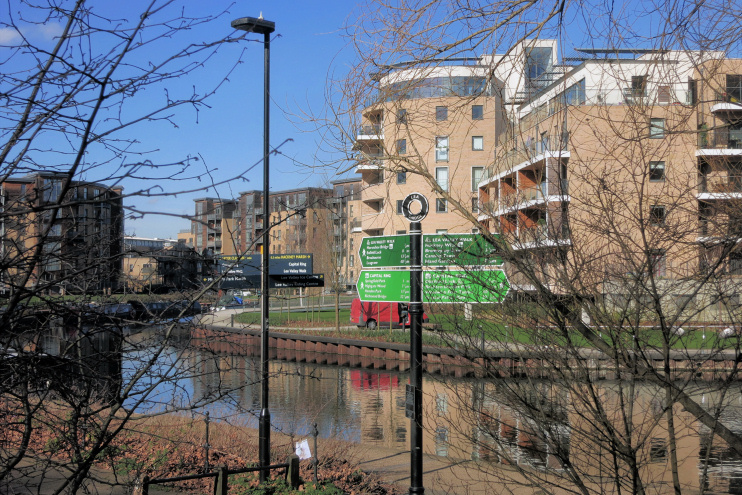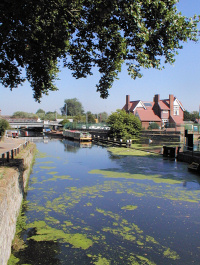Lea Bridge
Lea Bridge, Waltham Forest/Hackney
Until recently, an industrial and working-class residential district straddling the River Lea east of Clapton – now being gentrified

There has been water-related industry here since the time this place was called Jeremy’s Ferry. The first waterwheel was erected in 1707 and this was followed by mills grinding corn (and even pins and needles), and a water pumping station.
The construction of the Lea Bridge turnpike in 1758 improved accessibility to the City and the district became fashionable for a while with merchants and bankers.
The mills presented an obstacle to navigation, which was overcome by the opening of the Hackney Cut, from Lea Bridge to Old Ford, in 1769.
On the eastern side of the river, Lea Bridge Road station (opened in 1840 and renamed Lea Bridge in 1871) was the earliest railway connection in the Leyton and Walthamstow area and soon brought the construction of workers’ housing.
During the latter part of the 19th century filter beds were constructed on both sides of the river and in the 1930s factories replaced agricultural smallholdings. Some of the old utilities and industries have since closed and the Middlesex Filter Beds have become a nature reserve within the Lee Valley Regional Park. The western side of the district remained primarily residential, and is sometimes known as Millfields.
With EU funding, Lea Bridge underwent some regeneration at the end of 20th century, providing infrastructure improvements to its industrial estates – but this failed to prevent many businesses from closing or moving elsewhere.
Lately, property developers have been squeezing in upscale apartment blocks wherever planning permission can be obtained. The most recent major project has been The Wharf, a set of four blocks shoehorned in between Essex Wharf and the river – and shown in the photograph at the top.*

Having closed in 1985 as a consequence of underuse, a new incarnation of Lea Bridge station opened in May 2016. Waltham Forest council provided £5 million of capital funding for the project. Railfuture director Roger Blake said: “The initial spark was in 2011 when transport officers in neighbouring Hackney council … found there was £5 million funding available from the developers of Stratford City’s Westfield who were keen to expand their rail catchment northwards up the Lea Valley.” Built at a cost of more than £11 million, the station is ultimately expected to serve 352,000 passengers a year.
Development of the area around the station has been proceeding rapidly since it opened and there are proposals for much more to come, controversially creating an entire new ‘town centre’ here, with several residential tower blocks.
The rebuilt Lee Valley ice centre opened in June 2023. Somewhat amazingly, the £30m project was completed within budget. The centre is the only venue in the south of England to have two Olympic sized rinks. It also has a gym, dance studio, community spaces and café, and the surrounding area has been enhanced with £1.5 million-worth of landscaping, planting and environmental improvements. The neighbouring Lee Valley riding centre has an indoor riding school and outdoor hacking facilities, as well as offering carriage driving and side-saddle tuition.
Just over two-fifths of Lea Bridge’s residents are white and a quarter are black or black British. The Asian community is predominantly of Indian heritage on the Hackney side of the river and of Pakistani descent in Waltham Forest.
Postal districts: E5 and E10
Population: 29,710 (Hackney’s ward of Leabridge and Waltham Forest’s ward of Lea Bridge, 2011 census)
Station: Greater Anglia (zone 3)
Further reading: Waltham Forest Oral History Workshop, The Road to Jeremy’s Ferry, Waltham Forest Oral History Workshop, 2003
